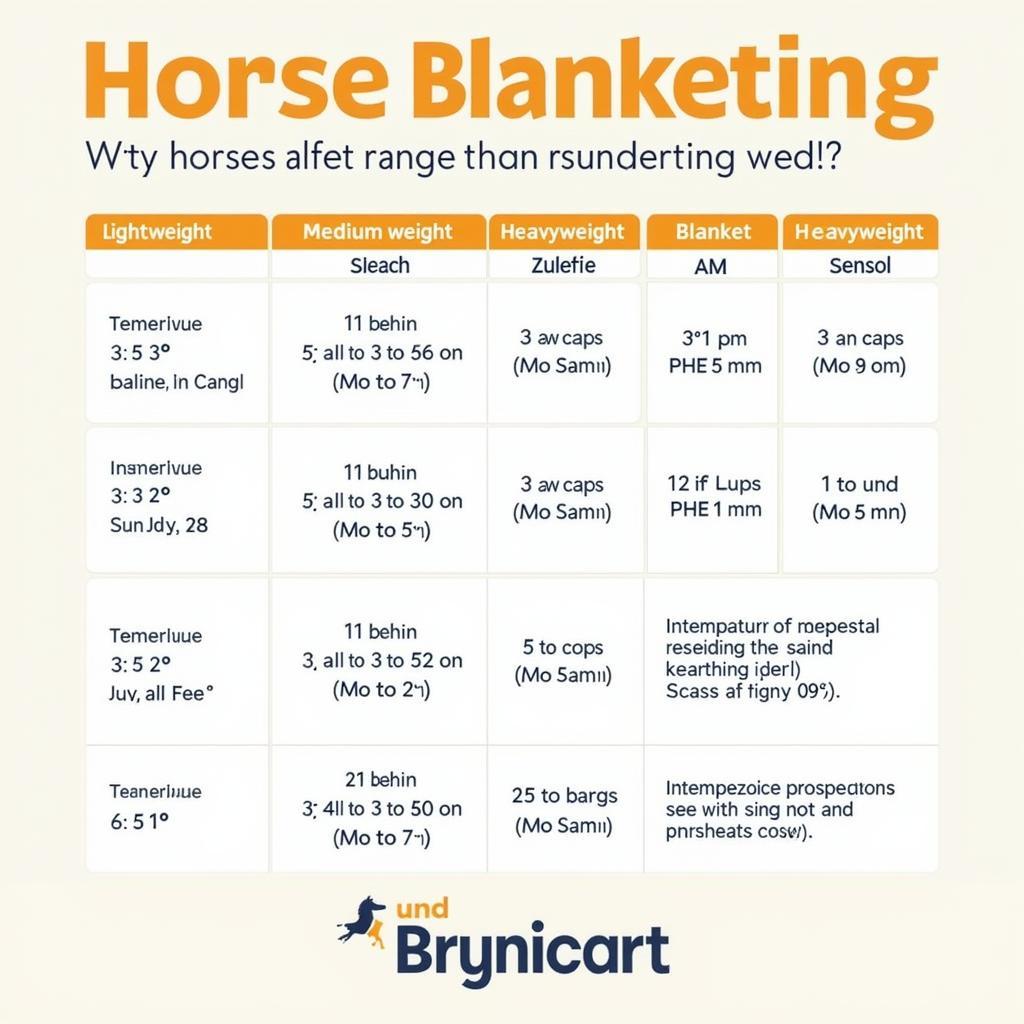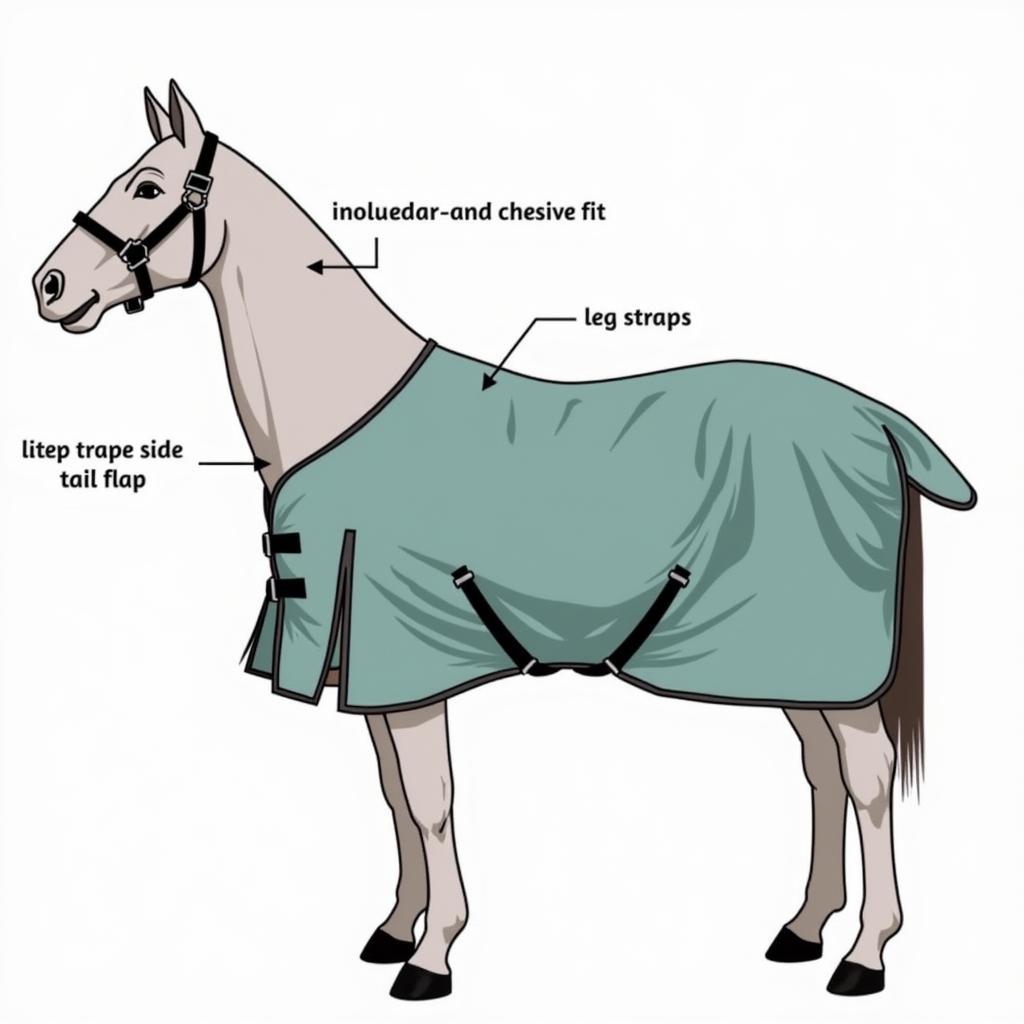Knowing when and how to blanket your horse can be tricky. A Blanketing Chart For Horses is an invaluable tool for horse owners, providing a quick reference for appropriate blanket weights based on temperature and weather conditions. This guide will delve into the intricacies of using a blanketing chart, empowering you to make informed decisions about your horse’s comfort and well-being.
Understanding the Importance of a Blanketing Chart for Horses
Horses, like humans, have individual temperature tolerances. Factors such as age, health, coat thickness, and whether they are clipped or not influence their need for blanketing. A blanketing chart provides a general guideline based on temperature, but it’s crucial to consider your horse’s specific needs. Using a chart helps avoid over-blanketing, which can lead to overheating and skin problems, and under-blanketing, which can leave your horse chilled and vulnerable.
 Horse Blanket Chart Guide
Horse Blanket Chart Guide
Decoding the Blanketing Chart for Horses: Temperature and Blanket Weight
Most blanketing charts for horses use temperature ranges to recommend blanket weights. Typically, temperatures above 60°F (15°C) require no blanketing unless there’s significant wind or rain. As temperatures drop, lighter blankets are recommended, progressing to heavier blankets for colder temperatures. For example, a lightweight sheet or blanket might be suitable between 50-60°F (10-15°C), while a medium-weight blanket is more appropriate between 40-50°F (4-10°C). Below freezing, a heavyweight turnout blanket is usually necessary. Remember to check the blanket temperature chart horse for a more detailed breakdown.
Beyond the Basics: Factors Affecting Blanketing Decisions
While the temperature is a primary factor, other elements influence blanketing choices. Wind chill significantly reduces the effectiveness of a horse’s natural insulation, requiring a heavier blanket than the temperature alone might suggest. Similarly, rain or snow necessitates a waterproof turnout blanket to keep your horse dry and warm. Older horses, clipped horses, and those with health issues often require more warmth than younger, healthy horses with full coats.
“A good rule of thumb is to feel your horse’s ears,” says Dr. Emily Carter, Equine Veterinarian. “If they feel cold, your horse likely needs more warmth. If they feel warm or even hot, you may need to remove a layer or opt for a lighter blanket.”
Blanketing for Specific Needs: Clipped Horses, Seniors, and More
Clipped horses require more careful blanketing as their natural insulation is reduced. You might find our horse winter blankets selection helpful. Senior horses often have difficulty regulating their body temperature and may benefit from heavier blankets, even in milder weather. Similarly, horses recovering from illness or injury may need extra warmth. It’s always best to consult your veterinarian for specific recommendations.
Choosing the Right Blanket: Material and Fit
The material of your horse blanket is just as important as the weight. Waterproof and breathable fabrics are ideal for turnout blankets, keeping your horse dry while allowing excess moisture to escape. Look for durable materials that can withstand the wear and tear of daily use. Proper fit is also crucial. A poorly fitting blanket can rub and cause sores, restricting movement, and even creating dangerous situations if it becomes tangled. Consider the Defender horse blanket for its durability and excellent fit.
 Horse Blanket Fit Guide
Horse Blanket Fit Guide
“Investing in high-quality blankets is essential,” advises Sarah Miller, Certified Equine Trainer. “A well-made blanket will last longer and provide better protection for your horse.”
Conclusion: Mastering the Art of Horse Blanketing
Using a blanketing chart for horses provides a valuable starting point for making informed decisions about your horse’s comfort and warmth. However, remember that each horse is an individual, and adjusting your blanketing strategy based on their specific needs is essential. By considering factors beyond the temperature, choosing appropriate materials, ensuring proper fit, and regularly checking your horse, you can ensure their well-being throughout the changing seasons. Don’t forget to check out our horse winter blanket sale for great deals on quality blankets. Keeping horse blanket notes can also be a great way to keep track of what blankets work best for your horse.
FAQ
- What is the ideal temperature for a horse blanket? There isn’t one single ideal temperature, as it depends on the horse. Refer to a blanketing chart and consider individual factors like age, health, and coat thickness.
- How do I know if my horse is too hot under a blanket? Check your horse’s ears and neck for warmth. Sweating under the blanket is another clear sign of overheating.
- What type of blanket is best for wet weather? A waterproof and breathable turnout blanket is essential for wet weather.
- How often should I check my horse’s blanket? Check your horse’s blanket at least once a day, especially in wet or windy conditions, to ensure it hasn’t shifted or become damaged.
- Can I leave a blanket on my horse all winter? While some horses may need blankets throughout the winter, it’s important to regularly assess their needs and adjust blanketing accordingly.
- My horse has a thick winter coat, do they still need a blanket? Horses with thick winter coats often don’t need blankets unless temperatures are extremely low, or the weather is particularly wet or windy.
- What are the different types of horse blankets available? Common types include stable blankets, turnout blankets, sheets, coolers, and quarter sheets, each designed for specific purposes and weather conditions.
Scenarios
- Scenario 1: A young, healthy horse with a full winter coat in 40°F (4°C) dry weather likely only needs a lightweight or no blanket.
- Scenario 2: A clipped horse in 30°F (-1°C) with light rain will need a medium-weight waterproof turnout blanket.
- Scenario 3: An older horse in 50°F (10°C) with strong winds may benefit from a medium-weight blanket even though the temperature is relatively mild.
Further Reading
Check out our other articles on horse care and blanketing for more information: “Choosing the Right Winter Blanket for Your Horse” and “Understanding Horse Blanket Weights.”
Need assistance? Contact us 24/7 at Phone: 0772127271, Email: [email protected] or visit us at QGM2+WX2, Vị Trung, Vị Thuỷ, Hậu Giang, Việt Nam.